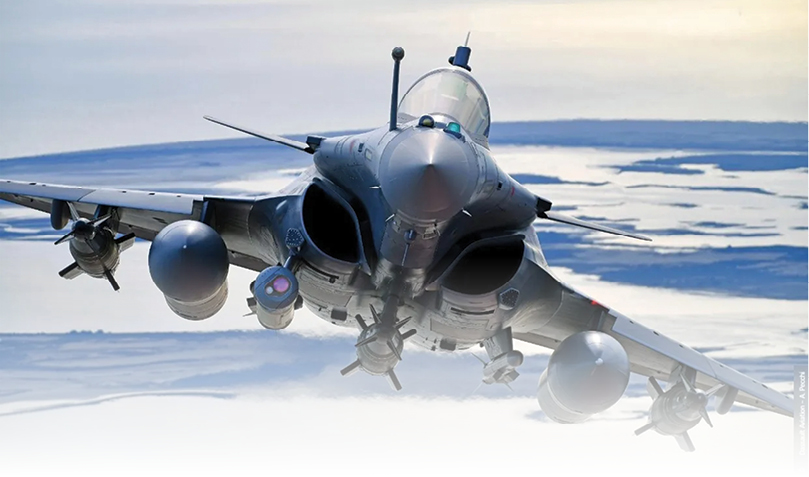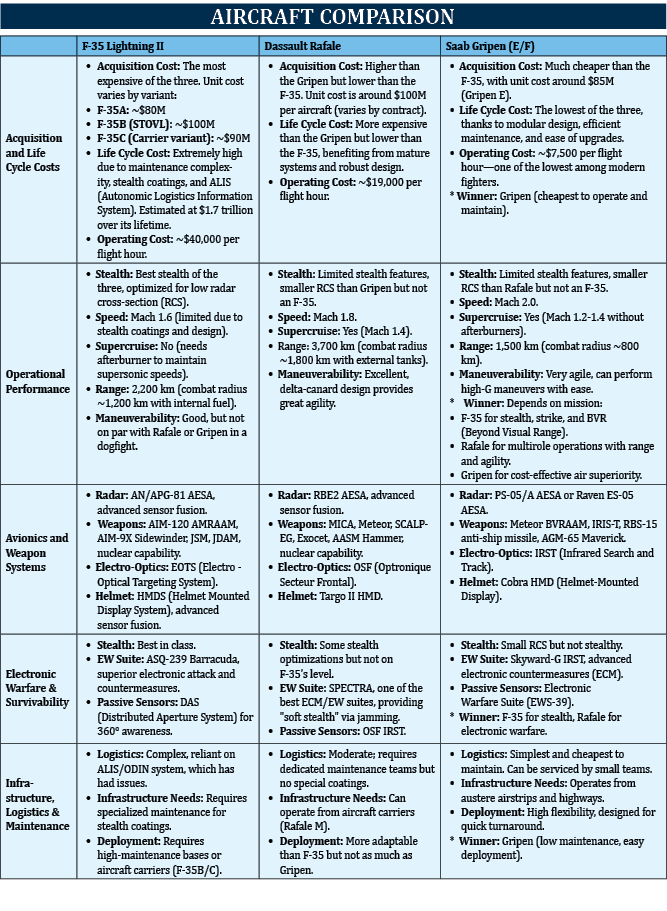
Articles
Why is the Gripen JAS-39 a Smart Choice for the IAF
Sub Title : A detailed insight into the mrFa debate which has dogged the iaF about its choice for the next combat aircraft
Issues Details : Vol 19 Issue 1 Mar – Apr 2025
Author : Gp Capt Anil Sharma (Retd)
Page No. : 38
Category : Military Technology
: April 15, 2025

India faces a critical decision in modernizing its air force amidst shifting global dynamics. With rising threats, budget constraints, and indigenous delays, the right fighter jet must balance performance, affordability, and strategic autonomy. The Gripen emerges as a compelling contender.
A major shift is underway in the International strategic landscape. The rules-based world order is already crumbling under the weight of no-rules, self-interest-based approach of the new American Presidency. Even as friend and foe line ups are in a muddle, India must beef up its security as it faces a dual-front challenge, with China to the North and Pakistan to the West. There are also signs of turbulence in our eastern flank. Air power will continue to play a dominant role in the security architecture of nation states. And while the nature of air power itself is changing with the new elements of AI, space and unmanned aerial vehicles, manned platforms will remain weapons of choice over longer ranges and where human decision-making is required.
Indian Air Force is not doing so well in that area. With its fighter squadron strength down to 30 against the authorised 42, it is almost 200 aircrafts short. A look at the horizon reveals a more dismal reality that the LCA and the MMRCA programs are both well behind schedule. Producing 8, or even 16, Tejas aircraft in a year is simply not enough, even if HAL continues to receive the GE engines uninterrupted.
In the long term, Atmanirbharta is indeed the answer to India’s defence needs – making its own fighter aircraft/ other airborne weapon systems being the pinnacle of defence manufacturing. But that is an evolving process and will take years to come of age. The question then is which aircraft suits IAF’s needs best in the interim. In terms of what the IAF needs, it is an aircraft that will bolster air superiority across multiple theatres. It must offer multirole versatility, high availability, low lifecycle costs, and be suitable for both frontline operations and rapid deployment. Additionally, the aircraft must integrate with existing IAF platforms, support ‘Make in India’ mandates, and enhance India’s indigenous defence ecosystem.
For a start, the IAF needs a larger number of versatile fighter aircraft which can operate effectively in a wide range of environments, from the high-altitude Himalayas to the Rajasthan desert to the thick jungles of the East. For political and strategic reasons, we may not want to put all our eggs in the Russian basket, particularly in the face of their increasing bonhomie with the Chinese. The focus therefore is on Western aircraft.
During the Prime Minister’s recent trip to USA, President Trump offered the F-35 Lightning II for the Indian Air Force. It is indeed a top of the line, 5th gen fighter with an array of modern weapon systems, electronic suites and stealth capability. However, the F-35 has been designed primarily for Western air forces with access to well-developed infrastructure. It is optimised for stealth penetration missions in heavily defended environments, which may not be India’s immediate priority. It is notorious for its extensive maintenance requirements, relying on a complex Autonomic Logistics Information System (ALIS) that requires constant data input and connectivity with Lockheed Martin’s global maintenance network. This dependence on external infrastructure will severely limit India’s operational autonomy.
The F-35 requires extensive infrastructure upgrades, including specialised maintenance facilities, advanced data integration centres, and new airbases optimised for its stealth capabilities. At a unit cost of over USD 100 million per aircraft it is almost unaffordable, particularly since we need large numbers. Operating costs, at $35,000 per flight hour are another critical factor. Given India’s vast air force and the need for sustained operations, the long-term costs of maintaining the F-35 fleet could place a significant financial burden on the defence budget. While the F-35 boasts superior stealth and sensor fusion capabilities, much of its technology is locked behind strict U.S. export controls. This means that India would have limited ability to customize the aircraft’s software or integrate its own weapon systems without U.S. approval. The F-35 does have superior electronic warfare capabilities, but its reliance on stealth means that once detected, it has fewer active jamming and countermeasure options. Furthermore, India would likely have limited access to the F-35’s full EW suite due to U.S. restrictions. While Indo-U.S. relations have improved, Washington has a history of imposing sanctions (such as CAATSA) and restricting military technology transfers.
The F-35 also relies heavily on its unique Mission Data Files (MDF) and ALIS maintenance system which makes it difficult to integrate with non-U.S. platforms and could lead to operational challenges in a multi-platform air force like India’s. Given past restrictions on platforms like the F-16 and Apache helicopters, it is unlikely that India would receive any significant technological leverage from an F-35 purchase. So, while the F-35 is undoubtedly a technological marvel, it is not the right fighter for the Indian Air Force. Its high costs, infrastructure requirements, maintenance complexity, and geopolitical restrictions make it a less attractive option for India.
Given the fact that the IAF already operates the French Rafale, additional aircrafts of the same type make a plausible case. IAF presently has two Rafale Squadrons, No.17 Squadron at Ambala and No. 101 Squadron at Hashimara, to cater to the operational requirements in the Western and Eastern sectors respectively.
However, the Rafale again has a high acquisition cost at about $100M per aircraft (varies by contract). The initial batch of 36 aircraft cost India Rs 59,000 crore including weapons, training and maintenance. Its Life Cycle Cost is moderate due to its mature systems and robust design, but it still comes at on operating cost of approx $19,000 per flight hour. It has limited stealth with a speed of M 1.8 and a combat radius of about 1800 Kms with external tanks. The aircraft no doubt comes with a good electronic suite and advanced weapons like MICA, Meteor, SCALP-EG, Exocet, AASM Hammer as also nuclear capability. And while there is commonality of infrastructure which has already been raised by the IAF, the problem comes with the high cost of acquisition, considering that the IAF needs a large number.
Rafale’s maintenance and spare parts, however, are also likely to become costlier due to the limited Global user base and reliance on French manufacturers. It is an entirely foreign built aircraft and spares, upgrades and software updates are entirely dependent on France unless there is the necessary technology transfer. The current IAF inventory of the Rafale is small but to buy more is an expensive proposition, given the numbers that are required. Unless there is technology transfer and larger numbers, the Rafale will continue to remain limited in some ways.
The Swedish Gripen, designed for rapid response and operations from dispersed locations, aligns well with the requirements of the IAF which include, above all, a fighter with excellent short take-off and landing (STOL) capabilities and high sortie rates—two areas where the Gripen excels. The IAF operates in a high-tempo environment, requiring a fighter that can be quickly turned around for multiple sorties per day. The Gripen boasts an exceptionally high sortie rate due to its ease of maintenance. A Gripen can be refuelled and rearmed in under ten minutes with a small ground crew, making it ideal for high-intensity operations and the number of operational missions that it can fly.
In terms of acquisition Cost, the Gripen E costs around $60-70 million per unit, making it a more affordable option for the IAF. It has one of the lowest operational costs among modern fighters, estimated at around $4,700 per flight hour, which is nearly a quarter of the Rafale’s and a mere 15 % of the F-35 operating cost. The Gripen, with its modular design and simplified maintenance, also ensures lower costs over its lifecycle. Designed for dispersed operations, it can take off from highways and operate from makeshift airfields with minimal logistical support—ideal for India’s diverse operational terrain.
The Gripen E/F is equipped with cutting-edge technology, including the AESA radar, IRST (Infrared Search and Track) system, and the Meteor Beyond Visual Range (BVR) missile, which gives it a decisive edge in air combat. It is also designed for interoperability and allows for easy integration of indigenous weapons like the Astra BVR missile and future Indian-made avionics. Known for its world-class electronic warfare (EW) suite, the Gripen can easily disrupt enemy radar and missile guidance systems. This is particularly crucial for India, given the advanced air defence networks fielded by both China and Pakistan.
There is also the advantage of going to a totally new source of acquisition since it takes India away from both US and Russia. Sweden is a country with a history of neutral and non-restrictive defence policies. This gives India more freedom in how it operates and modifies the aircraft. Additionally, Sweden offers full technology transfer for the Gripen, which will help India’s “Make in India” initiative.
The Gripen’s open-architecture software will also allow India to integrate its own weapons, radars, and avionics without external interference. India operates a diverse fleet, including Russian Su-30MKIs, French Rafales, and indigenous Tejas aircraft. The Gripen, with its NATO-standard avionics and open-architecture design, can seamlessly integrate with these platforms. India aims to strengthen its domestic defence industry through the “Make in India” initiative. Saab, it is understood, has offered full technology transfer and local production of the Gripen, ensuring that Indian companies benefit from manufacturing and R&D partnerships.
In conclusion, while there is no doubt about the superior technology and next gen features of the F-35, its acquisition and operating costs are prohibitive. While it is a clear winner in terms of operational performance – stealth, strike and BVR capabilities – it has a very long logistic and maintenance tail. Its design is also intended for integration with western weapons and radar systems making it a less attractive buy for the IAF. Rafale also emerges winner in terms of its multirole capabilities such as range and agility. It also has excellent electronic warfare capacity. However, maintenance and cost related issues make it heavy on the defence budget.
Gripen has often been termed the Technological Underdog with strategic advantages. Despite being a single-engine platform, the Gripen E/F brings several advanced technologies to the table, including AESA radar, superior electronic warfare suites, sensor fusion, and network-centric warfare capabilities. Its open-architecture design allows easier upgrades and integration with both Western and Indian systems. Its Meteor BVR missile compatibility, coupled with low observability and agility, makes it a formidable air superiority and strike platform. Its cost of acquisition and operating cost per hour are both low, a fact that allows a greater number of aircraft to be bought. Combine it with its high sortie rate and short turnaround time, and we have a multiplier effect.
Doing business with Sweden has the added advantage of staying clear of both Russia and America, avoiding any strategic entanglement. Sweden has supplied AWACS to Pakistan, but apparently there is no further business interest beyond that. Unlike other major powers, Sweden is not known to use defence exports as a tool for coercive diplomacy. This gives India greater autonomy in operational deployment. Saab has proposed full transfer of technology, indigenous assembly lines, and joint ventures with Indian private sector firms and DPSUs. It is reportedly willing to share source codes and allow Indian firms to develop and manufacture critical subsystems. This could significantly enhance India’s Atmanirbharta capacity. While there are no ‘one size fits all’ solutions in defence acquisitions, the Gripen JAS-39 does seem like a smart choice.



